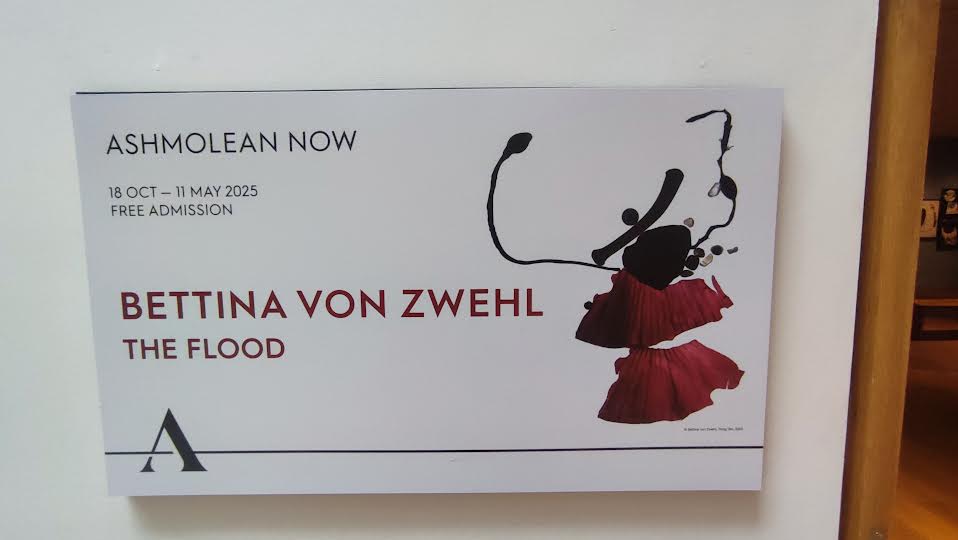Holly Graham: The Warp/ The Weft/ The Wake - Manchester Art Gallery - Review
★ ★ ★ ★ ★
As part of 20/20 project, Manchester Art Gallery is displaying Holly Graham's artwork/exhibition 'The Warp/ The Weft/ The Wake' until March 2026. It explores the legacy of colonialism and labour exploitation in the cotton industry, central to Manchester, and to the founding of The Royal Manchester Institute - which would later become the Manchester Art Gallery itself. Both Graham's final product, and the surrounding contextual archival material, are a resounding success - a shining example of explaining an artpiece in a way that doesn't reduce, but deepens the experience.
 |
It a Tuesday. This is the third attempt at taking notes on this exhibition. On the opening day, I had just finished a shift at my new coffee shop, and - seeing the room packed with visitors - decided against taking photos and notes, blocking the view of others. Yesterday, also after a shift, I tried again, forgetting the 'closed-on-monday' sector wide rule. But today I am back. After clocking out I spent some time in the 'Room to Breathe' gallery before heading here.
The artwork/exhibition is in the main flow of the building. It would be hard not to pass through this room. Previously, this room had displayed 'Stories of Women, Work and Uncertain Futures'. Now, 'The Warp/ The Weft/ The Wake'.
This is the title of the central artwork, around which the rest of the room is designed. Three parts of a costume dress stand proudly on a central isle. This piece was created as part of 20/20 project, a collaboration between the University of the Arts London and the Decolonising Arts Institute. Through it, '20 emerging artists of colour are matched with 20 UK public art collections, leading to 20 new permanent acquisitions'. The title draws on Christina Sharpe's concept of 'the wake' as an image for the ongoing reverberating effects of slavery.
Putting the artwork itself to one side for a second, I am interested in how this space has been set up to support the final piece.
 |
There are two blocks of wall text. Quite a lot of it. They cover the purpose of the room, the context of 20/20, the history of the cotton trade and its interlinkages with colonialism and imperialism, the history of the Manchester Art Gallery, and the History of Manchester. A lot of content to cover, but done relatively concicely. This room has a specific story to tell, and a lot of effort is put in to make sure that it is communicated effectively and consistently. It is clear that the central dress is intended to link together all of the stories told. It is also clear that we can use the other items around the room to put the pieces together.
 |
Graham has worked with a group of researchers (D. Reynolds, S. Robinson and E. Sinclair) to mine the archives, finding material evidence of the links between the Transatlantic Slave trade and Manchester's industrial history. This evidence is, of course, abundant, so the pieces selected for display in the gallery are potent. Most interesting to me was a patch book containing unaccessioned designs of cloth, intended to be manufactured for cheap and traded for enslaved people. To draw attention to this, the explanatory label had been printed on very thin tissue and inlaid into the book itself. This very effectivly linked story and object in a way I haven't seen before. It prevents the viewer from having to scan around for contextual information, potentially missing it. Instead, if you see the patch book, you see the information.
A small library is included, with introductory books to continue an exploration of the themes of the work. Displayed alongside it is a video documenting the construction process of the dress. Interestingly, this process included the act of mounting it in the exhibition space. The acknowledgement of installation as part of the creative process reinforces the space's dual reading as artwork/exhibition.
 | |
 | |
 |
Dominating one wall is a Where's Wally esque painting, depicting all the big wigs of the Manchester trading scene. A key, and some magnifying glasses, next to it provides a fun game of spotting certain individuals. Again, the linkages between wealth and exploitation are immediately apparent.
 |
 |
One section concerns Sarah Parker Remond, an Abolitionist and a black woman who's personal narrative intertwines with the history of the city. Graham displays records demonstrating her presence in the city at key moments.
 |
All of these sections work to contextualise the central artwork. They each feed into the piece in different ways. For instance, the dress is modelled approximately to fit Sarah Parker Remond. One pattern imitates a ledger, displayed elsewhere in the room. Another pattern, the inner marbling of a book recording the trade of enslaved peoples.
 |
This could have all been explained through text - present the artwork in isolation, accompanied merely by a panel of authorial voice. However, I am very glad that it wasn't. Allowing the exhibition to explain and develop the artwork is brilliant. The room simultaneously acts as the artists voice, and as justification for the creative choices which resulted in 'The Warp/ The Weft/ The Wake'
I will have to keep my eyes out for any other exhibitions resulting from the 20/20 project, for - if they are as innovative and comprehensive as this - then the project must be a resounding success.
Holly Graham's 'The Warp/ The Weft/ The Wake' is on display at Manchester Art Gallery until March 15 2026, and is free admission.
✬✬✬✬✬




Comments
Post a Comment